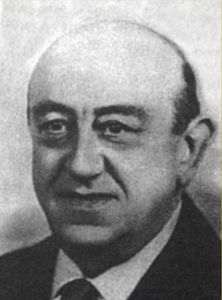Playwright and dialectal poet
Anton Luigi De Stefani, known as 'Gin', was born in Sanremo on 1 April 1887.
He was the son of Antonio and Antonietta D'Imporzano. He followed technical studies (even though he was already a theatrical correspondent for the magazine "Arte Drammatica" at the time) and was hired as a Postal Clerk and sent to Alessandria for a few years (which he endured with great sadness).
In 1914 he married Angela Balestreri, his faithful companion in a life that would not be gladdened by the birth of children.
During the First World War he wrote the poem Cavalleria Macabra and the first poem in Sanremo "A Gurpe e u Crovu", a translation of the well-known poem by Fedro, which was never published and has been lost.
From 1919, alternating with Vincenzo Jacono, he wrote a column for the Eco della Riviera in "Martellian" verse (the union of two septenaries) called "I ciapéti di véji" (the chatter of old men) where Mastr'Antò u Basté (him) and Bigin Sciacastrasse (Jacono) discussed among themselves.
In 1925, he wrote in a magazine "Arma u tò còtre e sèrca Carlandria", which the poster described as a "dialectal magazine in a prologue, four acts, six scenes and several scenes".
He wrote the comedy "U ciaravüju", considered the most beautiful comedy in Sanremo dialect, written together with Vincenzo Jacono.
The first performance was at the Teatro Pincipe Amedeo on 25 March 1930, followed by eight consecutive performances!
It was then performed in 1946 at the Teatro Centrale and at the Ariston in 1977 and 1886.
Other comedies
1951 - " L'Inveza de meriéli " (the desire of strawberries) - one act;
1951 - U trücu de Zanin" with Nini Sappia and Nicoletta Semeria;
1952 - " Büriana " (north wind) three acts, presented at the Centrale;
1956 - " L'estai de San Martin " comedy in three acts, performed on 25th February;
1958 - "A cà di spiriti";
1961 - " Dighe au luvu " which closes the trilogy with U ciaravüju and Büriana. Represented posthumously.
He was also prolific in the field of poetry, writing many poems and posies.
These include "U can da Cascéte", or "Pagine arrecampae da in vucabulariu ruixilàu dai ra-ti... " which, according to Franco D'Imporzano in his preface, have the gift of immediate popularity.
One of his most famous works, dated 1949, is "Padre Nostru", a translation in rhyme and San Remo dialect of the main Catholic prayer.
From 1932 to about 1953, he wrote an Italo-dialect column in the newspapers "La Gazzetta di Sanremo" and then in the "Eco della Riviera", "Mugugni de Steva Carabutin nostromu in Pensciun", which managed to liven up the monotony of the news in the newspapers (c.f.r. D'Imporzano).
In 1970, the Workers' Federation published its small poetic encyclopaedia "Grezümi in rima" (rough things in rhyme), edited by Giovanni Giribaldi.
In 1976, the Famija Sanremasca published the collection "Caru mei Campanin ! " which includes all the author's poetic production, with a preface by Franco D'Imporzano (cit.).
Both before and after the war, he animated the 'Piccolo Teatro Matuziano', which performed comedies at the Workers' Federation, with big names such as Nini Sappia, Nicoletta Semeria and Ninetto Silvano.
After him, in the 1970s, the "Compagnia Stabile Città di Sanremo" was born.
He died in Sanremo on 16th September 1961.
(source: Marco Mauro)





